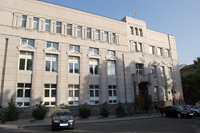We think that there would hardly be anyone in Armenia, who would confidently say that everything is perfect in the banking system of Armenia. The banks just like Najaryan from the movie “Golden Bull” don’t refuse but don’t give loans. It means there are issues connected with loans. This also directly confirms the decision of the government to provide a 20-billion AMD bank guarantees to constructors. This means that the banks fear to provide loans and the government says, “do it, I’ll be accountable.” What is the state of deposits? The return of deposits has always been painful for Armenia since the time the people lost their deposits during the collapse of the Soviet Union. Of course, after that the people’s trust to the banks has gradually been restored but now everybody confronted with the global crisis and everything was spoiled again. The bankruptcy of certain international banks due to the global crisis scared not only the potential deposit givers but also the ones, who have savings. Although our government insisted that everything was OK and that our financial system was stable, many bank customers would cash out their savings. And than of course we had March 2, when the USD reached 380 from 305 AMD within several hours. And the AMD savings of the people were devaluated by at least 25-30%. And so judging from this situation and talks among people we can say that the investment of deposits had drastically decreased. We are repeating that all this is said due to logic. Why do we emphasize this? The reason is that often the state statistical data don’t fit into common logic. And so the summary of the banks of Armenia publicized by the RA Central Bank shows that the deposits of physical entities within the first quarter of this year have increased by 16.2% and the deposits of legal entities – by 30.4%. The National Statistics Service (NSS) also publicized great data in its January-March 2009 report. Let us quote a sort part, “The remainder of the savings of the people (at the end of March 2009 – B.T.) amounted to 173.699 million AMD and grew by 19.292 AMD or by 12.5% compared to the last month.” One reads this and gets surprised. What crisis, what currency blast, what mistrust? It turns out that the Armenians not only got confused about the currency turbulence but also increased the amount of their savings. They have started to trust the banks more. The most interesting thing, however, is that the NSS and the CB data are correct and meanwhile incorrect. The small table of these data prepared by the NSS makes the whole picture more understandable.
The numbers mentioned in the above-mentioned paragraphs, the 12.5% growth of savings, are based on these data, which we’d like to mention we don’t have any grounds not to believe in. During one month the AMD deposit of households was decreased by 9 billion AMD or by 21%. This is already a very concerning index and shows that the Armenian citizens have started not to trust the AMD any more. Thus this 12.5% growth was registered due to the currency deposits. So now we reached the most interesting point. Pay attention, the table says currency deposit but the amount is mentioned in AMD. As of late February the currency deposits amounted to 112.1 billion USD; at the end of March – 140.4 billion AMD. It turns out the deposits in currency have increased by 25%. In fact it is not quite like that because for February the rate of late February was chosen and for March – one of late March. The readers with good logic have perhaps already figured out what “tricks” the CB and the NSS used here. However, let us continue. At the end of February the currency deposits amounted to 112.1 billion AMD or 367.5 million USD as the dollar cost 305 AMD but at the end of March the amount of deposits was 140.4 billion AMD or 379 million USD because the USD cost 370 AMD at the end of March. It turns out that the currency deposits grew only by 3%. In order to make this more understandable let us bring an example. Let us suppose last year Paul had 1000 USD savings at the bank. At the end of the year the bank releases his balance and says he has 305.000 AMD. On the next day Paul goes to the bank and withdraws 100 USD and leaves the rest of the 900 USD till the end of the year. At the end of March the bank once gain releases his balance statement – 330 thousand AMD (900 x 370). The bank releases the statement and says that Paul’s savings increase by 28.000 AMD or by 9%. This is the logic, which the NSS uses to publicize numbers. Of course, it would be more honest if the currency deposits were indexed. It means that instead of the 112.1 billion AMD of February they could have written 136 million. So why don’t they do it? Because that way it would be impossible to show growth. And in Armenia as you know the most important thing is the numbers.

